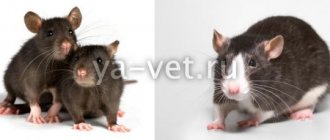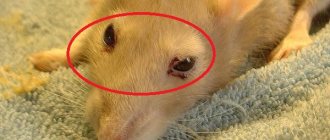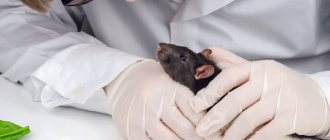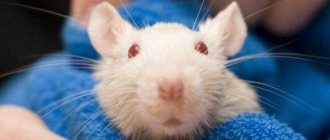According to statistics, from 50 to 60% of decorative rats are asymptomatic carriers of mycoplasmosis. Clinical signs in the form of damage to the respiratory system may appear with decreased immunity, dietary errors, hormonal or age-related changes.
And since complications of mycoplasmosis in rats lead to death, it is important to know the main symptoms of this pathology and begin proper treatment in a timely manner.
Symptoms of Mycoplasmosis in rats
Many experts argue that Mycoplasmosis is recognized by characteristic symptoms that are easy to notice and difficult to confuse with signs of other diseases. The main external symptoms of the disease are:
- Sneezing
. The rodent's breathing is accompanied by wheezing. - Deterioration in the condition of the animal's fur
. The rat's fur becomes dull, unkempt and disheveled. - Weight loss.
The animal completely loses interest in food. - Formation of paraffin in the eyes and nose of a rodent.
Many owners may confuse this discharge with blood.
The rat may also have internal signs of this disease that the pet owner may not be able to notice. The main symptom is the formation of blisters and boils on the animal’s lungs. These formations usually cause pneumonia. It can also cause an infection in the female's uterus. If the female's internal organs are affected, the animal's genitals may begin to bleed. Every day the animal may become worse and worse, and if help is not provided to the pet in time, it may die due to organ damage or lack of air.
An important factor in effective treatment of the disease is recognition of mycoplasmosis in the early stages. Until the animal is in critical condition, it can still be helped. However, if the disease quickly gains momentum due to vitamin deficiency, ammonia vapors emanating from a dirty cell or other toxic factors, then death is inevitable.
Preventive actions
There is no protection against mycoplasma infection. The only thing the owner of a pet rat can do is try to minimize the risk of disease. Measures that will help achieve this include the following:
- Providing a complete and balanced diet (including feeding with vitamins).
- Creation and maintenance of optimal comfortable living conditions.
- Avoid contact between your pet and sick animals.
- Maintaining hygiene (regular cleaning of the animal’s cage, etc.).
It would also be a good idea to wash your hands every time before touching your pet, just in case. As you know, preventing a disease is easier than curing it.
Treatment of Mycoplasmosis in rats
There is no cure or vaccine for Mycoplasmosis. However, the infection and symptoms can be controlled with antibiotics in the early stages of the disease, but are more likely to develop into a chronic condition requiring periodic or even ongoing treatment. This disease progressively worsens, eventually causing hardening of the lungs and abscesses in the lungs, leading to death.
White rats are widely used in laboratories
Some antibiotics that have proven effective against mycoplasmas are Tetracycline, Tylosin, Gentamicin, Amikacin, Chloramphenicol, Doxycycline and Enrofloxacin (Baytril). The doses are as follows:
- “Tetracycline” orally from 5 to 10 mg per 500 g of weight three times a day for at least 14 days.
- Tylosin orally 4.5 mg per 500 g of body weight twice a day or 66 mg per liter of water for 14-30 days.
- “Gentamicin” (best used in combination with cefadroxil) at a dose of 1-2 mg per 500 g is administered twice a day for 7-14 days.
- “Amikacin” at a dose of 5 mg per 500 g of weight is administered twice a day for 7-14 days.
- “Chloramphenicol” in a dose of 15 to 25 mg per 500 g is administered twice a day for 7-14 days.
- Doxycycline orally 2.5 mg per 500 g twice a day for 14-30 days.
- “Enrofloxacin” (“Baytril”) orally 5 mg per 500 g twice a day for 14-30 days.
Baytril and Doxycycline also work very well in combination.
In later stages of the disease, corticosteroids such as Prednisone (given in addition to antibiotics) may help reduce inflammation. By reducing inflammation in the infected lungs, the rat can breathe more easily, resulting in less frequent choking episodes, thereby prolonging the rat's life.
Another drug useful for severe cases of pneumonia is Aminophylline. This drug relaxes and dilates the bronchi, helping the rat breathe easier. Dosage: 2.5 to 5 mg per 500 g orally or administered two or three times daily.
Also during treatment the following recommendations must be followed:
- Clean your rodent's home regularly.
- Disinfect your pet's cage with special products every day.
- Constantly ventilate the room.
- Control the optimal room temperature.
- Clean up your pet's waste as often as possible.
The injection method is recognized as the most effective method of administering drugs. However, many owners do not know how to give injections. For the subcutaneous method, it is necessary to insert a needle into the crease of the neck. Intramuscular injections are made into the hind legs. For injections it is better to use isulin syringes. Also, to perform the manipulation you will need the help of another person who will hold the animal. It is important to remember that after taking antibiotics, the rat will need to be given probiotics.
Diagnosis of mycoplasmosis
Diagnosis of mycoplasmosis, due to the lack of symptoms or similarity of manifestations with other diseases, can be very difficult.
Classic cytological analysis does not always give the correct result due to the small size of the bacterium; bacteriological culture is accompanied by difficulties in selecting special nutrient media.
With the advent of the PCR technique, polymerase chain reaction, the diagnosis of mycoplasmosis has become more accurate. The probability of detecting mycoplasma using PCR is about 96%. Therefore, for correct diagnosis it is necessary to conduct a comprehensive examination, including:
- Bacterial culture
- PCR analysis
- Immunofluorescence analysis
During pregnancy, it is necessary to take into account the number of pathogenic pathogens during laboratory tests.
Regular visits to doctors will allow you to detect the problem in a timely manner, avoid complications and transmission of infection. If you have the listed symptoms, you can contact doctors such as a venereologist, immunologist, or gynecologist.
Caring for a rat after illness
A healthy pet needs your care. Immediately after treatment, the rodent must be provided with a high-calorie diet. This is necessary because the animal may lose a lot of weight during treatment. It is worth feeding your pet baby formula or puree.
It is important to ensure that your pet does not become infected with any infections, as his immunity is very weak. Therefore, the animal should be temporarily isolated from other pets. Also protect your rat from drafts and low temperatures.
Can mycoplasma bacteria be transmitted to humans or infect other animals?
The owner of a sick pet should not worry about his own safety - the bacteria that provoke the disease in rats are not dangerous to humans. In total, science knows more than 30 varieties of mycoplasma bacteria, of which 6 species are pathogenic for humans. Rat mycoplasmas are not one of them (unlike mouse mycoplasmas).
A sick rat cannot infect animals of other species either, but it can easily infect its relatives. Therefore, if several rats live in a house and one of them is sick, it should be immediately isolated, otherwise the rest of the rats will also get sick.
Disease prevention
Stress or other illnesses can weaken your rat's immune system and cause your rat to develop Mycoplasmosis. If left untreated, this disease can lead to pneumonia. Therefore, it is very important to provide your pet with a calm environment. This includes providing an unfilled, well-ventilated, clean cage with safe bedding material in which to live at all times. This will eliminate any possibility of accumulation of ammonia from urine and feces or phenols from cedar and pine, which can damage the protective abilities of the animal's respiratory system. It is also very important not to expose your pet to other animals that may be sick, as a secondary bacterial or viral infection can allow Mycoplasma infection to develop very quickly into pneumonia, which can lead to death.
Some of the bacteria that may accompany Mycoplasma pulmonis in respiratory illnesses and may worsen symptoms include Pasteurella pneumotropica, Streptococcus pneumonia, Bordetella bronchiseptica, CAR bacillus (cilia-associated respiratory bacillus) and Corynebacterium kutscheri. Viral infections such as SDA virus (sialodacryoadenitis) and Sendai virus in combination with mycoplasma can also quickly lead to death. The SDA virus is common in the pet rat population, so be especially careful. Quarantine any new rats you bring into your home for at least two weeks.
Rat mycoplasmosis: description of the disease and symptoms
Disorders of the respiratory system are provoked by several pathogens, the most common of which is the non-enveloped bacterium mycoplasma. According to research, mycoplasma bacteria live in the bodies of more than 60% of rodents that visually appear healthy (the presence of microorganisms in these animals is asymptomatic).
Mycoplasma infection is dangerous, as it often leads to the death of the infected rodent. The development of mycoplasmosis in domestic rats is due to the following reasons:
- exposure to unfavorable external factors (inappropriate living conditions, etc.);
- age-related changes (the main risk group includes individuals aged 1 year and older);
- general weakening of the immune system.
Usually the infection is transmitted by air from rodent to rodent (an animal can also be infected by a person who has been in contact with a sick rat). The disease manifests itself primarily with respiratory symptoms:
- frequent sneezing;
- rapid fatigue;
- loss of appetite;
- shortness of breath;
- cough;
- apathy;
- runny nose (rhinitis);
- lethargy;
- lack of mobility;
- respiratory wheezing;
- development of bronchitis and pneumonia;
- discharge from the nose and eyes of porphyrin fluid (red mucus that resembles blood).
But respiratory symptoms are not the only characteristic manifestations. Other characteristic signs of infection in rats include:
- impaired coordination of movements;
- exhaustion;
- unkempt appearance (disheveled, dull fur, etc.);
- skin itching;
- damage to the middle or inner ear (the animal’s head is tilted to one side);
- the appearance of scratching;
- weakness;
- the appearance of bald spots and bald spots in the coat;
- decreased body temperature;
- damage to the vestibular apparatus.
An additional symptom in females is purulent-bloody vaginal discharge.
The disease is divided into several stages and develops gradually - the more symptoms appear, the more advanced the disease.
What is the mortality rate in rats with mycoplasmosis disease?
Mycoplasmosis in rats does not always cause trouble for the animal. It is very rare for a pet with a strong immune system and an active lifestyle to become infected with a dangerous infection. Constant monitoring of the animal by a veterinarian will help avoid infection with mycoplasmosis. Follow these rules regularly:
- monitor your pet's condition;
- take preventive medications.
If you do not follow these recommendations, the death of your pet may occur not due to mycoplasmosis, but from re-infection with the infection. Then the main organs of the rat are affected and the treatment loses its effectiveness.
Treatment and care
Treatment of mycoplasmosis in rats is effective only at the initial stage of the disease, so treatment of animals must begin when the first alarming symptoms appear.
After the appearance of severe clinical signs of pneumonia and otitis media, experts make a cautious prognosis, since even in the case of temporary recovery, relapses are inevitable.
Important! To treat mycoplasmosis in rats, it is prohibited to use penicillin antimicrobial drugs, as they can cause anaphylactic shock in animals.
The regimen and duration of treatment are determined by the stage and form of mycoplasmosis.
| Form of mycoplasmosis | Duration of treatment | Medications | Additional therapies |
| Light form | From 7 to 10 days | Antibiotics: chloramphenicol, doxycycline, tylosin, azithromycin | Improving living conditions, replacing sawdust bedding with paper napkins |
| Moderate severity of infection | From 10 to 14 days | Antibiotics, mucolytics, bronchodilators (salbutamol) | Aerosol therapy, placing the rat in a room with steam |
| Severe form | From 14 to 45 days | Antibiotics, blood replacement drugs for infusion therapy, corticosteroid drugs (depomedrol, prednisolone) | Oxygen therapy, maintenance therapy |
The most appropriate treatment for inflammation of the female reproductive system is ovariohysterectomy, which is performed under general inhalation anesthesia. The operation is performed against the background of antibiotic therapy, followed by symptomatic treatment.
Important! In the advanced stage of otitis, when inflammation spreads to the inner ear and the rat loses orientation in space due to dysfunction of the vestibular apparatus, treatment is ineffective. In this case, the doctor may suggest euthanasia to ease the animal's suffering.
During treatment of mycoplasmosis, special care is required for the sick rat. It is necessary to ensure that the bedding is replaced as it gets wet. This will prevent ammonia vapors from entering the animal’s respiratory tract, which complicate the course of the disease.
In the room where a sick rat is kept, you should regularly do wet cleaning and turn on a humidifier. It is also prohibited to spray aerosols, smoke, or use strong-smelling household chemicals (glass and carpet cleaners, polishes, etc.).
Porphyrin released from the nasal cavity and eyes must be removed using a cotton pad moistened with saline solution.
Vitamin and mineral supplements should be included in the diet of rodents.
References
- Plakhova, K.I. Clinical significance of genetic variability of genital mycoplasmas. – Bulletin of Dermatology and Venereology, 2015. – No. 2. — P.76-83.
- Savicheva A.M., Shpitsina, E.V. Genital mycoplasmas. - Doctor, 2009. - No. 1. — P.9-12.
- Federal clinical guidelines for the management of patients with urogenital diseases caused by Ureaplasma spp., Mycoplasma Hominis; Moscow, 2015. - 24 p.
- Dessi, D., Margarita, V., Cocco, A. et al. Trichomonas vaginalis and Mycoplasma hominis: new tales of two old friends. - Parasitology, 2022. - Vol. 146(9). — P. 1150-1155.











